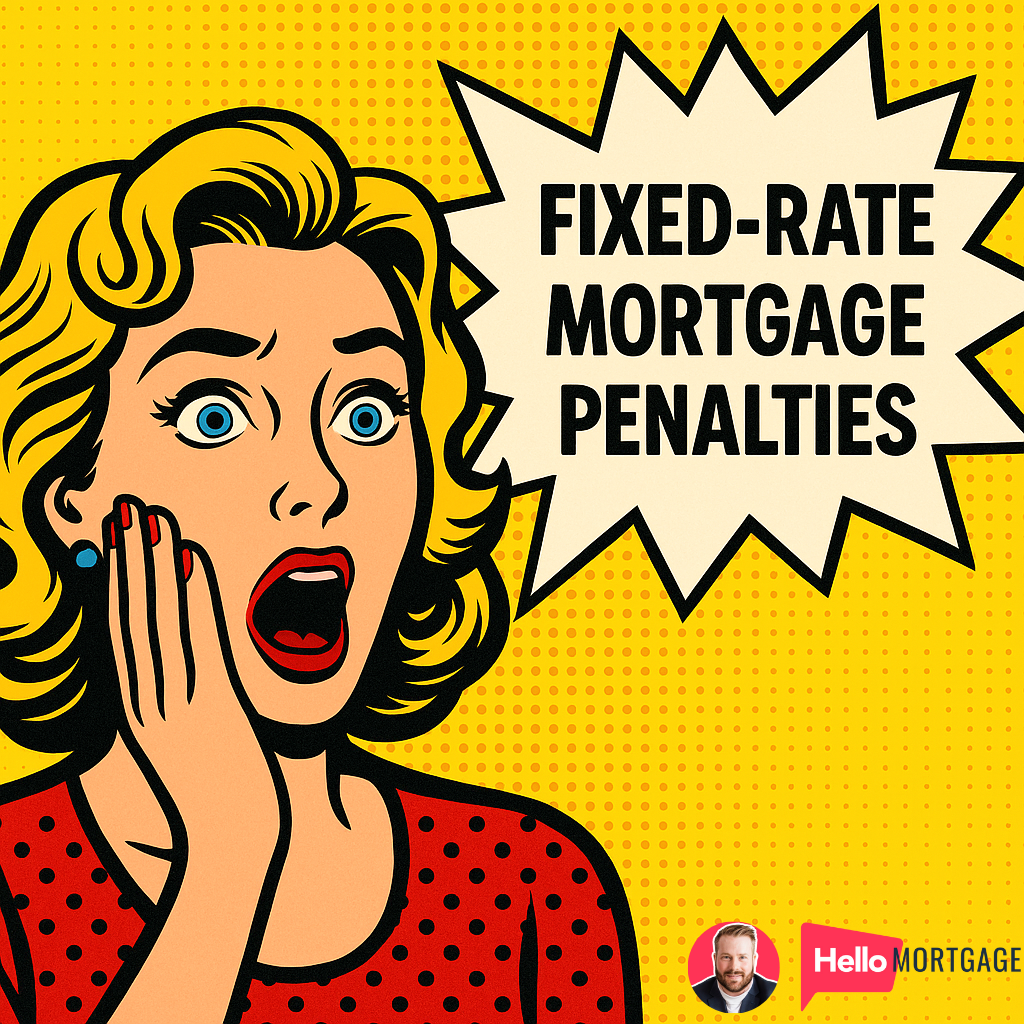Why Mortgage Penalties Matter
No one plans to break their mortgage. But life happens — divorce, job change, relocation, upgrading your home, or consolidating debt. In fact, about a third of Canadians end up breaking their mortgage before the term is up.
And when that happens, penalties can range widely. On a typical five-year fixed mortgage of $250,000, breaking it at the three-year mark could cost you anywhere from $1,150 to $9,500, depending on your lender.
That’s not pocket change.
The Basics: 3 Months’ Interest vs. IRD
Most Canadian lenders use a standard phrase in their contracts:
“The greater of three months’ interest or the Interest Rate Differential (IRD).”
- Three months’ interest is simple: you pay the equivalent of three months of interest charges on your mortgage balance.
- IRD (Interest Rate Differential) is trickier. It compares your contract rate to another rate based on your remaining term. The kicker? The way your lender defines that “other rate” can change your penalty from a manageable fee into a wallet-busting shock.
Let’s walk through each version — the good, the bad, and the ugly.
Step 1: Three Months’ Interest
This is the simplest penalty calculation and the “backup option” if the IRD comes out lower.
Assumptions:
- Five-year fixed-rate mortgage at 1.84%
- Current balance: $250,000
- Three years into the term (two years left)
Formula:
(1.84% × $250,000 × (3/12)) = $1,150
So, if you broke this mortgage today, the three-month interest penalty would be $1,150.
Not too painful — but don’t get too comfortable yet.
Step 2: The Standard IRD Penalty (the “fair” version)
What it means: This method is used by many broker-friendly monoline lenders. They compare your contract rate to their current market rate for the term that most closely matches the time you have left. It’s straightforward and consumer-friendly.
Example:
- Contract rate: 1.84%
- Current two-year fixed rate: 1.79%
- Difference = 0.05%
Formula:
(1.84% - 1.79%) × $250,000 × (24/12) = $250
Since lenders charge the greater of three months’ interest or IRD, your penalty here would be $1,150 (because $1,150 > $250).
| Your Contract Rate | Current 2-Year Rate | Mortgage Balance | Months Remaining | IRD Penalty |
|---|---|---|---|---|
| 1.84% | 1.79% | $250,000 | 24 | $250 |
Fair, predictable, and transparent. The kind of math you don’t mind.
Step 3: The Discounted-Rate IRD Penalty (the Big Bank twist)
What it means: This is the method used by RBC, TD, BMO, Scotia, and National Bank. Instead of comparing your rate to today’s actual shorter-term market rate, they take the discount you originally received off their inflated five-year posted rate — and then apply that same discount to the posted shorter-term rate.
It sounds like a harmless detail. Spoiler: it isn’t. Because short-term posted rates don’t get nearly the same discounts, this formula pushes your penalty way up.
Example:
- Five-year posted rate at origination: 4.79%
- Your discount = 2.95% (4.79 – 1.84)
- Current two-year posted rate: 3.19%
- Minus discount = 0.24%
Formula:
(1.84% - 0.24%) × $250,000 × (24/12) = $8,000
| Your Contract Rate | Posted 2-Year Rate | Original Discount | Adjusted 2-Year Rate | Balance | Months Remaining | IRD Penalty |
|---|---|---|---|---|---|---|
| 1.84% | 3.19% | 2.95% | 0.24% | $250,000 | 24 | $8,000 |
And just like that, your penalty jumps to $8,000. That’s a very expensive way to learn what “discounted” really means. Ouch.
Step 4: The Posted-Rate IRD Penalty (the “Grand Daddy” of them all)
What it means: This is the formula CIBC uses. Instead of factoring in the discount you actually received, they go by the posted rates at the time you signed and the posted rate that most closely matches your remaining term.
Since posted rates are artificially inflated (and rarely what anyone pays), this method almost always results in the highest penalty.
Example:
- Original posted five-year rate: 4.79%
- Current posted two-year rate: 2.89%
- Difference = 1.90%
Formula:
(4.79% - 2.89%) × $250,000 × (24/12) = $9,500
| Five-Year Posted Rate (at origination) | Current Posted 2-Year Rate | Balance | Months Remaining | IRD Penalty |
|---|---|---|---|---|
| 4.79% | 2.89% | $250,000 | 24 | $9,500 |
At $9,500, this penalty earns the nickname “The Grand Daddy of Them All.” And no, that’s not the kind of grandparent you want to meet.
Why This Matters for You
Mortgage penalties aren’t about whether a lender should charge one. Breaking a contract costs them money, and it’s reasonable to cover that.
The real issue is fairness and transparency.
- Broker-friendly lenders/monolines = ~$1,150 penalty
- Big Six (Discounted method) = ~$8,000 penalty
- CIBC (Posted method) = ~$9,500 penalty
When most borrowers don’t even know these differences exist, it’s easy to see why the big banks prefer to keep this buried in the fine print.
How to Protect Yourself
- Ask upfront how your penalty will be calculated. Don’t just accept “three months or IRD” — clarify which IRD formula applies.
- Work with a broker. We have access to lenders that use fairer penalty structures, which can save you thousands if life takes a turn.
- Think strategy, not just rate. The lowest posted rate might come with the most punishing penalties. Sometimes a slightly higher rate with fairer terms is the smarter long-term move. Mortgages are about more than just today’s rate. The fine print matters — and ignoring it can cost you dearly.
my mission is to help you not only secure a competitive rate but also avoid costly surprises hidden in the details.
If your mortgage is up for renewal, or if you’re considering breaking your mortgage early, let’s talk strategy. Book a call with me here.


.png)
.png)
